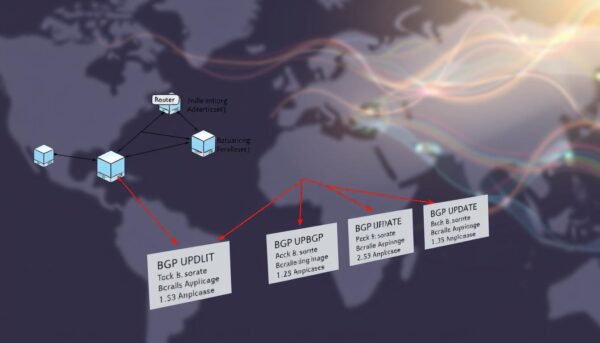✅ Last checked on
Ever wondered how data moves across the internet? It’s thanks to Border Gateway Protocol (BGP). This protocol helps data packets travel between networks, making sure your online activities are smooth.
BGP is key to the internet’s connectivity. It connects different networks and systems. With over 940,000 IPv4 and 182,000 IPv6 routes, it manages a vast network.
Autonomous systems use BGP to share routing info. This protocol helps networks find the best paths. It keeps the internet stable by sending messages every 60 seconds.
BGP plays a big role in finding the best routes. It’s vital for complex networks needing to connect to many providers. This makes BGP essential for many organizations.
Key Takeaways
- BGP is the primary protocol for routing between autonomous systems on the internet
- It manages over 940,000 IPv4 and 182,000 IPv6 routes globally
- BGP uses TCP connections on port 179 for stable peering relationships
- The protocol supports both external (eBGP) and internal (iBGP) routing
- BGP is crucial for multi-homed networks connecting to multiple providers
- Proper BGP configuration is critical to prevent widespread internet disruptions
Understanding Border Gateway Protocol Fundamentals
BGP routing is key to the internet’s complex network. It directs traffic between about 60,000 networks, showing its big role in connecting the world.
What is BGP and Its Role in Internet Routing
Border Gateway Protocol (BGP) is the internet’s backbone. It works at the transport layer of the TCP/IP model. BGP’s main job is to share routing info between networks, making sure data moves smoothly across the internet.

Core Components of BGP Architecture
BGP’s architecture has several important parts. These include:
- Peer connections: Set up manually between routers
- Routing tables: Hold info on available paths
- BGP attributes: Help pick the best path
BGP attributes are key in choosing the best route. They look at things like how many hops, local preference, and path age to decide.
Evolution from EGP to Modern BGP
Since 1989, BGP has changed a lot. The latest version, BGP-4, was approved in 2006 and works with both IPv4 and IPv6. This change has helped BGP handle the internet’s growing complexity better.
| Feature | BGP | OSPF |
|---|---|---|
| Network Size | Large (Internet-scale) | Small to Medium |
| Route Updates | Only when changes occur | Periodic |
| Failover Speed | Slower | Faster |
| Route Capacity | Higher | Lower |
BGP is great for big networks but has its challenges. It can be vulnerable to security threats and takes longer to update than OSPF. Yet, BGP is vital for the internet because it can handle a huge number of routes.
BGP Path Selection and Route Advertisement
BGP route advertisement is key to keeping networks connected well. When a new network is added, BGP routers send updates to their neighbors. This lets them update their routing tables.
Route Advertisement Process
The updates from BGP tell routers about network reachability. Routers use this info to find the best paths to destinations. This keeps routing decisions up-to-date with the network’s current state.

Path Vector Protocol Mechanics
BGP is a path vector protocol. It keeps and shares path info for each route. This helps avoid routing loops and makes policy-based routing possible.
Best Path Selection Criteria
BGP routers pick the best path using a complex algorithm. They look at different attributes and follow a specific order. This ensures the best path is chosen.
| Criteria | Description |
|---|---|
| LOCAL_PREF | Default value is 100 for paths without specified LOCAL_PREF |
| AS_PATH Length | Shorter AS_PATH is preferred |
| Origin | IGP routes have lower origin code than EGP routes |
| MED | Lower MED is preferred when paths have same neighboring AS numbers |
| IGP Cost | Lower IGP cost to the BGP next hop is preferred |
Knowing these criteria helps network admins improve BGP routing. This ensures data moves efficiently across the internet.
Internal vs External BGP Implementation
BGP implementations are divided into two types: Internal BGP (iBGP) and External BGP (eBGP). Each type has its own role in network routing. iBGP works within one autonomous system, while eBGP connects different systems.
iBGP Configuration and Use Cases
iBGP is key for keeping routing info consistent within a network. It needs a full mesh topology, where all routers connect directly. This setup prevents routing loops and ensures smooth communication.
In iBGP, routers don’t change the next hop when sharing routes. This makes internal routing efficient. iBGP is also used in stub autonomous systems for services like MPLS-based VPNs and IP multicast.
eBGP Deployment Scenarios
eBGP is used for connecting different autonomous systems. It’s common between organizations or when linking to an Internet Service Provider. Unlike iBGP, eBGP doesn’t need a full mesh topology, making it more flexible.
When sharing routes with an eBGP peer, the next hop changes to the local router. This helps keep path info accurate across networks. eBGP uses AS path for loop prevention, ensuring efficient routing between autonomous systems.
Differences Between iBGP and eBGP
The main differences between iBGP and eBGP are in their operational characteristics:
- Administrative Distance: eBGP has a lower default value (20) compared to iBGP (200).
- Route Advertisement: eBGP routes can be advertised to both eBGP and iBGP peers, while iBGP routes can only be advertised to eBGP peers.
- Loop Prevention: eBGP uses AS path, while iBGP relies on BGP Split Horizon.
- TTL Values: eBGP peers have a default TTL of 1, whereas iBGP peers have 255.
Knowing these differences helps network admins pick the right BGP implementation. This ensures the best routing performance and network stability.
BGP Path Attributes and Route Policies
BGP path attributes are key in choosing the best path to a network. They give detailed info about routes, helping routers decide. Knowing about BGP path attributes is essential for making good BGP route policies.
The BGP decision process looks at several path attributes to pick the best route:
- Weight: A Cisco-specific attribute ranging from 0 to 65,535. Higher values are preferred.
- Local Preference: Used within an AS, with a default of 100. Higher values indicate higher preference.
- AS Path Length: Shorter paths are preferred to prevent routing loops.
- Origin: IGP is preferred over EGP, which is preferred over Incomplete.
- Multi-Exit Discriminator (MED): Lower values are preferred, ranging from 0 to 4,294,967,295.
BGP route policies let network admins tweak these attributes. By applying filters and changing attribute values, you can shape route selection and traffic flow. This flexibility helps improve network performance, add security, and meet specific routing goals.
When making BGP route policies, think about how different attributes work together. For instance, eBGP paths are usually chosen over iBGP paths. In close calls, BGP looks at things like the IGP metric, router ID, and neighbor IP address. By grasping these details, you can create strong policies that meet your network’s needs.
Autonomous Systems and BGP Peering Relationships
In the world of internet routing, Autonomous Systems (AS) are key. They are identified by unique AS numbers. These numbers are vital for BGP routing between different networks across the internet. Knowing about AS numbers and types helps us understand how BGP connects the world.
Understanding AS Numbers and Types
AS numbers are unique identifiers for autonomous systems. There are two main types: single-homed and multi-homed. Single-homed AS connects to just one ISP, while multi-homed AS connects to many for better performance and redundancy.
Establishing BGP Neighbor Relationships
BGP peering relationships use AS numbers. Peers share routing information through their ASNs. This is important for businesses wanting to cut costs and boost network performance. BGP runs on TCP port 179, with keepalive messages sent every 30 seconds to keep connections alive.
Multi-homing and Route Redundancy
Multi-homing means connecting to multiple ISPs for better performance and redundancy. This setup needs careful BGP configuration to manage traffic well. ISPs use local AS numbers during network changes, making it easier to add new networks without disrupting BGP sessions.
| Peering Type | Description | Benefits |
|---|---|---|
| Public Peering | Conducted through Internet Exchange Points (IXP) | Multiple network connections via single point |
| Private Peering | Dedicated IP connection between networks | Ideal for high-volume traffic exchange |
BGP Security and Network Stability
BGP security is key to a stable internet. It handles over 95% of inter-domain routing. Studies show 80% of BGP issues come from mistakes, making strong security essential.
Route Filtering and BGP Security Best Practices
Route filtering is crucial for BGP security. It stops unwanted route ads and keeps your network safe. Here are some best practices:
- Carefully configure neighbor relationships
- Use prefix filters
- Apply AS path filters
- Implement community-based filtering
Preventing Route Hijacking
Route hijacking is a big threat. To fight it, follow these steps:
- Use Resource Public Key Infrastructure (RPKI)
- Do origin validation
- Keep an eye on BGP announcements
- Join MANRS initiatives
Authentication and Session Protection
Securing BGP sessions is crucial. Here’s how to boost authentication and protect your sessions:
- Use MD5 for BGP peer authentication
- Do TTL security checks
- Limit BGP session rates
- Keep BGP software up to date
| BGP Security Measure | Adoption Rate | Impact on Network Stability |
|---|---|---|
| RPKI Implementation | 40% growth in last year | Significant reduction in route hijacking incidents |
| BGP Monitoring Tools | 30% increase among ISPs | Improved detection of anomalies and potential leaks |
| MANRS Participation | Growing industry-wide | Enhanced global routing security and reliability |
Conclusion
BGP’s role in today’s world is huge. It’s the main way the internet talks to itself since 1994. It makes sure data moves smoothly between different networks.
You’ve seen how BGP uses special messages to keep connections strong. It has a system that makes sure these connections are reliable. This system is key to the internet’s stability.
As we look ahead, BGP is getting better at stopping problems like route leaks. New ways to keep the internet safe are being worked on. BGP will keep helping the internet stay connected and safe from attacks.
Knowing how BGP works helps you understand the internet better. It’s getting better all the time. BGP will keep making sure our data gets where it needs to go safely and quickly.